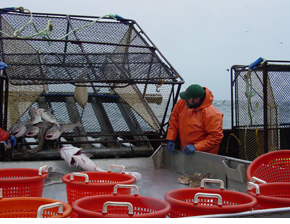Status of Stocks & Multispecies Assessment Program
Essential Fish Habitat Environmental Impact Statement
The Final Environmental Impact Statement for
Essential Fish Habitat Identification and Conservation in Alaska (EFH
EIS) is nearing completion. Status of Stocks & Multispecies Assessment
(SSMA) staff and analysts from the AFSCís Auke Bay Laboratory and RACE Division
completed substantial revisions and additions to Appendix B: Evaluation of
Fishing Activities That May Adversely Affect Essential Fish Habitat.
A new and innovative quantitative fishing effects model served as the
basis for evaluating potential adverse effects of fishing on EFH. This
model and the subsequent assessment methodology were the subject of an
independent peer review by the Center for Independent Experts (CIE) in
June 2004. The North Pacific Fishery Management Councilís Scientific and
Statistical Committee (SSC) also provided extensive comments on various
technical aspects of Appendix B.
Appendix B was greatly expanded to address the comments and
recommendations by the CIE review panel, the SSC, and the public. The
analysts considered habitat effects with respect to species
distribution, spawning/breeding, growth, condition (e.g., weight at
length), feeding, and stock trends. Although the Appendix B analyses
concluded that fisheries do have long-term effects on habitat, these
impacts were considered minimal and would not have detrimental effects on
fish populations or their habitats. Nevertheless, continuing with its long
history of precautionary, ecosystem-based management
policy, the Council adopted several new and significant measures to
conserve EFH at its February 2005 meeting. The specifics of these
measures can be found on the Councilís web site at www.fakr.noaa.gov/npfmc/current_issues/efh/efh.htm.
By Dan Ito
Cod Local Depletion Study Completes Successful Field Season
| |

Peter Munro of the Fisheries Interaction Team (FIT) during the winter FIT survey inspects
as Pacific cod dump from the pot onto the sorting table. Photo by Sandi Neidetcher. |
REFMís Fishery Interaction Team has completed a third
year of winter cruises for the Pacific cod local depletion study near
Unimak Pass in the southeast Bering Sea. This yearís cruises were
conducted 8-28 January 2005 (before the start of the cod trawl fishery)
and 12-31 March 2005 (after the main portion of the winter trawl
season). The experiment, developed in 2002-03 under the Steller Sea Lion
Research Initiative, is designed to test for the presence of local
depletion effects from the winter trawl fishery on seasonal aggregations
of Pacific cod. At issue is whether commercial fisheries affect food
availability for endangered Steller sea lions by creating a localized
depletion of sea lion prey.
Both winter 2005 cruises were highly successful,
achieving good replication over the full array of 80 experimental
stations. Auxiliary studies of cod spawning biology, temporal patterns
in pot catch rate, and effects of depth and physical oceanography on
catch rate were also completed. Project scientists M. Elizabeth Conners,
Peter Munro, Yunbing Shi, and Sandi Neidetcher will present results of
the experiment to the North Pacific Fishery Management Council at its
June meeting in Girdwood, Alaska, and at the September meetings of the
American Fisheries Society in Anchorage, Alaska.
This year is the third replication of the local
depletion study. The experiment uses the 10-nautical mile (nmi) no-trawl
boundary zone around Cape Sarichef on Unimak Island to define "treatment"
(subject to heavy trawl fishing) and "control" areas (open
to fixed gear, but closed to trawling). Both zones intersect a shelf
area at 40-50 fathoms that has historically been a popular cod trawling
ground. The experiment uses modified pot gear to measure an index of
local cod abundance. The goal of the experiment is a statistical test of
whether cod local abundance in the trawled area declines relative to the
control area.
Results of the experiment in 2003 and 2004 showed no
differences in cod local abundance or in the seasonal rate of change in
abundance between the treatment and control areas. While 2003 results
were considered inconclusive due to a small sample size, 2004 results
were based on a full sample of three to five fishing days at each
experimental station in each cruise and had good statistical power.
Analysis of auxiliary biological and tagging data collected during the
experiments indicated that cod in the study area were highly mobile over
short time scales. The experiment is designed to look for a local
depletion effect that covers a small area (5-10 nmi) and persists in
time over several weeks. The negative results of the 2004 experiment
suggest that fishing effects may be dispersed over a wider spatial scale
or may not persist long enough to be measured. The experiment is being
repeated to see if these results are consistent over year-to-year
changes in ocean conditions and timing of cod spawning migrations.
By M. Elizabeth Conners
>>>continued

|

|
Quarterly sidebar
AFSC Quarterly Research Reports Jan-Mar 2005
Contents
Feature
ABL Reports
NMML Reports
RACE Reports
REFM Reports
Items
Quarterly Index
Quarterly Home
|

